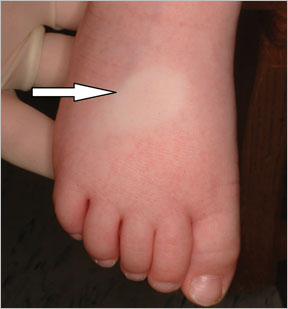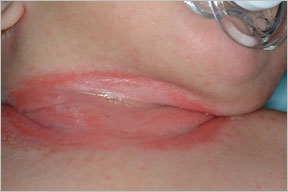3-year-old male presents with acute fever, pink papular rash

A 3-year-old male presents with acute onset of fever with a light red rash that is covered with fine, sandpaper-like papules. His appetite is unchanged, but he seems fussy, especially during defecation and diaper changes. There are no known sick contacts, but the patient is in day care 5 days a week. His immunizations are documented up to date.
Examination reveals a fever (temperature of 102° F), a clear throat exam, normal tympanic membranes and clear lungs. His skin reveals a diffuse, very fine light pink rash (Figures 1 and 2), with arrows showing where my finger pressed on the skin, to demonstrate the delicate erythema, with widespread, fine papules, which are similar to sandpaper. The rash appears to have circumoral sparing. The patient’s anal exam revealed some erythema about the perianal area (as shown in Figure 3), along with some yellowish material that appeared to be coming from the anal opening. This material was cultured and is pending.

Figure 1.The patient's foot showing the light pink rash with arrows indicating where my finger pressed on the skin, demonstrating the delicate erythema.

Figure 2.The patient's back, showing similar erythema as the foot.

Figure 3. Perianal erythema and yellowish exudate.
Source: Brien JH
Case Discussion
This patient has scarlet fever secondary to Streptococcus pyogenes cellulitis of his perianal area (B). This case demonstrates a few points: young children tend not to have streptococcal tonsillopharyngitis. However, they do have streptococcal infections elsewhere, and the perianal area is fairly classic. The diagnosis is often missed by not examining the patient’s anal area or failing to elicit a history of fussiness with defecation or diaper changes. However, group A streptococcus infections in this area or anywhere else can nonetheless cause the rash of scarlet fever. Treatment, as with other group A streptococcal infections, is recommended to be with oral penicillin or an injection of penicillin G benzathine. However, other choices are equally effective. As with older patients with scarlet fever, one can expect the patient to have some desquamation during the second week of the illness.


The pinworm (Enterobius vermicularis) is a very common, small roundworm that children of all ages may have from time to time; it can result in irritation in the anal area from frequent scratching, which might progress to some inflammation. However, one would not expect to see a diffuse rash or fever as a result of pinworm infestation. Parents can use pyrantel pamoate without prescription or albendazole with prescription; both are given as a single dose that is repeated 2 weeks later.
Staphylococcal perianal cellulitis is usually associated with an abscess (Figure 4). One can certainly see a rash with staphylococcal infections if it is caused by a strain that liberates one of the various rash-producing toxins, such as toxic shock toxins or epidermolytic toxins, both of which are fairly dramatic compared with the light rash of scarlet fever. Culture should guide therapy.
Candida dermatitis is very common in children wearing diapers, and may be primarily in the perianal area. However, the rash appears to be wet, usually with more diffuse erythema and satellite lesions, as shown on the anterior neck area of the patient in Figure 5. Additionally, one would not expect to see an exudative discharge from the anal area as a consequence of Candida diaper dermatitis. In severe cases, fluconazole may be used. Otherwise, topical antifungal cream may be indicated. In either case, good cleaning and drying at least twice a day should be done.
- For more information:
- James H. Brien, DO, is with the department of infectious diseases at McLane Children’s Hospital, Baylor Scott & White Health, Texas A&M College of Medicine in Temple, Texas. He also is a member of the Infectious Diseases in Children Editorial Board. Brien can be reached at: jhbrien@aol.com.
Disclosure: Brien reports no relevant financial disclosures.
Columnist Comment
Polio has largely become a forgotten disease in this country, since the disease has long since been eradicated from the U.S. (1979). In fact, as of now, the disease exists only in Afghanistan, Pakistan and Nigeria, with global eradication potentially on the horizon (as noted in the April issue of Infectious Diseases in Children).
The development of the first polio vaccine (1955) has been rightfully credited to Jonas Salk. However, there was a team of researchers that Salk assembled that included six others at the University of Pittsburgh. The last survivor of the team, Julius Youngner, PhD, died on April 27 at 96 years of age. To read more about this milestone and great investigator, visit this column at the New York Times.
When I was a young child, before the Salk vaccine was available, summertime (like now) would often herald the onset of another polio outbreak, striking a deep, widespread fear in parents; a feeling young parents today have never experienced on such a broad scale.
